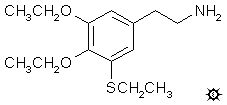
#178 3-T-TRIS
3-THIOTRESCALINE; 3-THIOTRISESCALINE; 3,4-DIETHOXY-5-ETHYLTHIOPHENETHYLAMINE
|
| [3D .mol structure] |
A solution of 14.9 g methyltriphenylphosphonium bromide in 200 mL anhydrous THF was placed under a He atmosphere, well stirred, and cooled to 0 °C with an external ice water bath. There was then added 27.6 mL of 1.6 N butyllithium in hexane which resulted in the generation of a yellow color which was at first transient, and then stable. The reaction mixture was brought up to room temperature, and 6.8 g 3,4-diethoxy-5-(ethylthio)benzaldehyde in 50 mL THF was added dropwise dispelling the color, and the mixture was held at reflux on the steam bath for 1 h. The reaction was quenched in 800 mL H2O, the top layer separated, and the aqueous phase extracted with 2x75 mL of petroleum ether. The organic fractions were combined and the solvents removed under vacuum to give 12.0 g of the crude 3,4-diethoxy-5-ethylthiostyrene as a deep yellow oil.
A solution of 5.6 g of borane-methyl sulfide complex (10 M BH3 in methyl sulfide) in 45 mL THF was placed in a He atmosphere, cooled to 0 °C, treated with 11.6 g of 2-methylbutene, and stirred for 1 h while returning to room temperature. To this there was added the crude 3,4-diethoxy-5-ethylthiostyrene in 25 mL THF and the stirring was continued for 1 h. The excess borane was destroyed with about 2 mL MeOH. There was then added 11.4 g elemental iodine followed by a solution of 2.2 g NaOH in 40 mL hot MeOH. This was followed by sufficient 25% NaOH to minimize the residual iodine color (about 4 mL was required). The reaction mixture was added to 500 mL H2O containing 4 g sodium hydrosulfite. This was extracted with 3x75 mL petroleum ether, and the pooled extracts stripped of solvent under vacuum to yield 24.5 g of crude 1-(3,4-diethoxy-5-ethylthiophenyl)-2-iodoethane as a viscous yellow oil.
This crude 1-(3,4-diethoxy-5-ethylthiophenyl)-2-iodoethane was added to a solution of 11.1 g potassium phthalimide in 80 mL DMF, and all was heated on the steam bath for 1.5 h. It was then flooded with 600 mL H2O, made basic with NaOH, and extracted with 3x100 mL Et2O. Removal of the solvent under vacuum provided 18.5 g of a residue that was dried to a constant weight by heating under vacuum (0.2 mm/Hg). The solid residue was ground under MeOH, and then recrystallized from MeOH providing 1-(3,4-diethoxy-5-ethylthiophenyl)-2-phthalimidoethane as white granular crystals, with a mp of 86.5-87.5 °C. Anal. (C22H25NO4S) C,H.
The recrystallized 1-(3,4-diethoxy-5-ethylthiophenyl)-2-phthalimidoethane was dissolved in n-butanol, treated with 66% hydrazine, and the mixture heated on the steam bath for 1.5 h. This was then added to dilute H2SO4, the butanol separated, the aqueous phase washed with 2x75 mL Et2O. After being made basic with aqueous NaOH, the aqueous phase was extracted with 3x75 mL CH2Cl2 and the solvent removed under vacuum to provide a pale amber oil. This was distilled at 140-155 °C at 0.25 mm/Hg to give about 1 g of a white oil. The distillate was dissolved in 5 mL IPA, neutralized with concentrated HCl, and treated with 10 mL anhydrous Et2O to give a solution from which a white crystalline product slowly separated. These crystals, 3,4-diethoxy-5-ethylthiophenethylamine hydrochloride (3-T-TRIS) weighed 1.1 g and had a mp of 161-162 °C. Anal. (C14H24ClNO2S) C,H.
DOSAGE: greater than 160 mg.
DURATION: unknown.
QUALITATIVE COMMENTS: (with 160 mg) There were no effects. At the 9th or 10th hour after having taken the material I was aware of some neurological irritability. I will not try this at any higher dosage, and let me stretch things a bit by a few percent in good conscience and say that this is less active than mescaline. This would allow it to be reported as < 1 M.U.
EXTENSIONS AND COMMENTARY: The term "M.U." pops up here and there in a lot of the earlier literature on these phenethylamines. It stands for "mescaline units" and was used to give a quantitative measure for the relative potency of a compound. Since it became obvious quite early in these studies that mescaline, although the prototypic compound, was probably going to remain the least potent, it seemed reasonable to use it as a bench mark of unity. By dividing the dose needed of mescaline (to produce central effects) by the dose needed of another drug, one would generate a number that represented just how many times more potent this new drug was than mescaline. I used this term in a very early review of the one-ring psychotomimetics, and it served satisfactorily for quite a while.
Its intrinsic worth proved, however, to be its very limitation. It was quickly apparent that the principal value, to behavioral researchers, of the reports of new hallucinogenic drugs, was not in the nature of their action but in the amount of stuff needed to produce that action. This was an essential axis against which the animal pharmacologist could plot his findings. A number was wanted, and the mescaline unit was just that number. Sadly, the major question that is asked by most academic researchers in their evaluation of the psychedelic materials is, "How much does it take," rather than "What does it do." The marvelous nuances of action, the subtle variations of effect, are dismissed as being hopelessly subjective and thus without scientific worth. But they are, I believe, of great worth. That is exactly what this book is all about.
| [ |
[Main Index] | [Forward |

